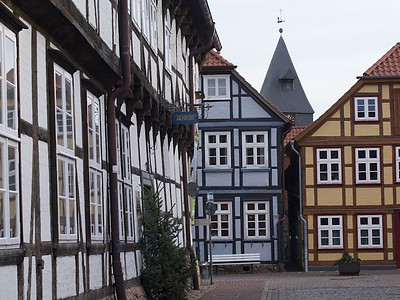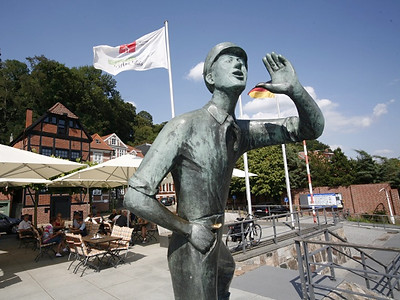Urban Experience
Bleckede
A town on the Elbe River attracts visitors with its half-timbered houses, culture and ambience. The charm of Bleckede attracts many guests. Many roads lead to the town of Bleckede, most of which lies in the Elbe glacial valley. Whether by historic train, by car via the German Stork Road, German Half-timbered Road, Lower Saxony Mill Road or Lower Saxony Asparagus Road, by bike via the Elbe Cycle Path, by boat on the Elbe, by ferry across the Elbe or on one of the many hiking trails, such as the long-distance hiking trail E6 - the destination is the city centre with your half-timbered houses. Whether in the street café, in the beer garden, in restaurants or while shopping - pure relaxation is the order of the day with the guests in the small harbour town on the Elbe. A natural environment, embedded in the biosphere reserve Niedersächsische Elbtalaue and a multitude of interesting sights, such as the Biosphaerium Elbtalaue in the Elbe Castle Bleckede, provide variety.

Winsen (Luhe)
Winsen, the typical Elbe town, lies nestled between marsh and heath. The varied landscape makes Winsen a central starting point for excursions and leisure activities. The rivers Luhe and Ilmenau are ideal for canoeing. On the Elbe, adventure and excursion trips are offered. The unique marsh landscape invites you to cycle. Not only Germany's most popular long-distance cycle route - the Elbe Cycle Route - but also many other river cycle routes and regional round trips cross the city area. Those who visit Winsen's old town for the first time stop at the Schlossplatz. The bronze sculptures of the fairy tale "The Golden Goose" by the Danish artist Arne Ranslet are a beloved photo motif.

Hanseatic City of Lüneburg
Lovable, liveable, and beautiful: Lüneburg is one of the liveliest cities in Northern Germany. Here you stroll on cobblestones through the 1050-year-old Hanseatic city with its closed medieval townscape. At the same time, the colourful and lively hustle and bustle in the alleys pulsates. Shopping in over 400 well-stocked specialist shops in the Hanseatic city of Lüneburg is a pure pleasure. By the way, this is one of the most serene Christmas markets in the world.
Salt – white gold
But Lüneburg is much more than a gateway to the Elbe river landscape. For more than 1,000 years salt was processed in the salt works, and the trade with the then precious "white gold" brought the town prosperity and prestige in the Middle Ages. Everywhere in the city centre one encounters the former wealth. The Lüneburg Kurpark, laid out according to the English landscape pattern, also bears witness to clever urban planning. Right next to the Kurpark, the brine in the "SaLü" salt baths is still bubbling today. You can also inhale it: in the Kurpark there is a graduation tower, from which brine drips down and sprays fine salty fog – a refreshment for the lungs. Museums, theatres, festivals and many more attractions – Lüneburg is worth a trip.
www.lueneburg.info

Free and Hanseatic City of Hamburg
Hamburgers are proud of their "most beautiful city in the world". The second largest city in Germany has developed into a pulsating world metropolis over 1,200 years. The centre is the port of Hamburg on the Elbe, which serves the world's largest cruise ships such as the Queen Mary 2, or the multi-storey container ships.
Southern flair in the north
Water plays a role everywhere in Hamburg. For example, there are more bridges here than in Venice. In addition to the Elbe, the Alster River determines inner city life. In the middle of Hamburg, the Upper and Lower Alster provide a southern flair. When the boats cruise against the wind with white sails and canoes pull through the canals, you watch from the many cafés and start dreaming.
A gigantic architectural challenge is currently emerging on the Elbe: the Hafencity (Harbour City). One of the city's most expensive (and controversial) projects can already be admired from the outside: the Elbe Philharmonic Hall. Hamburg is also one of the greenest cities in Europe, with extensive parks. The Free and Hanseatic City of Hamburg has also made a name for itself as Germany's musical capital – and the Reeperbahn is open all night.
www.hamburg-tourism.de

Hitzacker – the musical city on the river Elbe
The renowned spa resort of Hitzacker is picturesquely situated on the Elbe, surrounded by the Elbe valley meadows in the middle of Lower Saxony Elbe Floodplain Biosphere Reserve. Small alleys lead between the medieval half-timbered houses. The lively city life includes its own vineyard, the most northerly where a rather dry wine is cultivated. Hitzacker is famous for two very well-known and active music festivals, which have made a name for themselves in the classical music scene throughout Europe. The three museums also offer a varied look back at life in and around Hitzacker.

Lauenburg – the sailor’s town
Sightseeing boats are particularly fond of docking in this picturesque sailor’s town. While strolling through the picturesque old town, the colourful half-timbered houses and relics of old princely buildings on the banks of the Elbe are enchanting. High above the Elbe is the old castle – today an administrative building. The tower can still be climbed. In the shipping museum, there is much to see about Lauenburger shipping industry.
www.lauenburg.de


